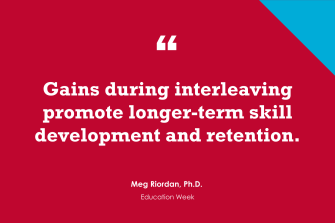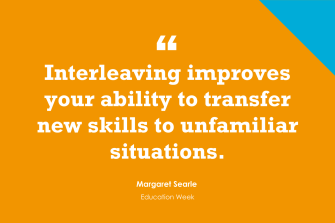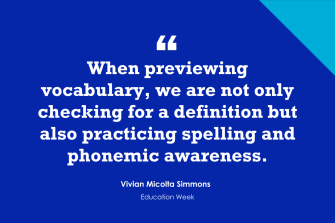The new question-of-the-week is:
What is “interleaving,” and how do you practice it in the classroom?
The teaching and learning strategy of interleaving has been gaining more and more attention from researchers and educators.
Today, four educators discuss what it is and how it can be applied to classroom practice.
‘Mix It Up’
Meg Riordan, Ph.D., is chief learning officer at The Possible Project, an out-of-school program that collaborates with youth to build entrepreneurial skills and mindsets and provides pathways to careers and long-term economic prosperity. She has been in the field of education for over 25 years as a middle and high school teacher, school coach, college professor, regional director of NYC Outward Bound Schools, and director of external research with EL Education:
“Do the best you can until you know better. Then when you know better, do better.” - Maya Angelou
What is interleaving?
Across the world, students generally engage in learning that looks like this: They are taught and practice one concept or skill at a time in blocks that form a sequence: AAABBBCCC. For instance, beginning writers may first practice identifying only nouns; then, after some targeted practice, students may shift to learning how to recognize verbs; then come adjectives. Or, a tennis player might focus on mastering her forehand again and again before building up to a backhand swing. This “one-skill-at-a time” approach—commonly called blocked or massed practice—emphasizes single-mindedness, searing learning into our minds or bodies, similar to creating muscle memory. It’s a way to learn the fundamentals through continual repetition.
But what if we knew that lasting learning or mastery pointed to a different approach—one called interleaving, to “mix it up” (ABCABCABC) and helped learners learn more deeply by practicing combinations of concepts with each other? Learning like this means interspersing multiple (but related) concepts to encourage connections between ideas or skills. For instance, if students are learning to classify rocks and identify the difference between igneous, sedimentary, and metamorphic, interleaving research points to mixing up examples of these rocks (ISMISMISMISM) instead of massing practice on igneous (IIII), then on sedimentary (SSSS), and then metamorphic (MMMM). And for athletes, to train muscles to adapt to different circumstances and improve reaction to various shots, the tennis player alternates forehands, backhands, and volleys—even if she hasn’t quite yet mastered each individually.
Numerous studies across fields like mathematics (algebra and geometry), athletics (baseball and basketball), music, and medicine suggest that interleaving leads to key benefits for learners:
- Interleaving trains the brain to traverse between concepts by creating different practices rather than relying on rote response or muscle memory.
- Interleaving deepens long-term memory (brain and muscle) associations because mind and body are retrieving various responses.
- Interleaving requires students to discriminate among problem types and select a problem-solving strategy.
How does interleaving transfer to classroom practice?
To be clear, interleaving doesn’t mean dismissing the fundamentals or never employing blocked practice; instead, it means avoiding the kind of massed practice that creates thoughtless repetition. But how can educators strategically create opportunities for students to solve a mix of related problems versus solving blocks of just one kind of problem, especially when most textbooks and curriculum aren’t intentionally designed in this way? Teachers can explore and integrate the following ideas that The Learning Agency Lab lifts up:
- Shrink the change—select fewer practice problems: Most textbooks chunk blocked-practice opportunities of addition (++++), subtraction (-----), multiplication (xxxx), then division (////). Teachers will need to mix up these different problems to help students learn not just how but also when. Students will still learn the fundamentals of each, but teachers can modify class work that moves among topics; this means choosing fewer interleaved problems for students to practice.
- Leverage station-based experiences: Teachers can introduce several related concepts at an introductory level and then engage learners in practicing these various concepts at stations. For instance, if studying volumetric problems of cones, pyramids, cubes, and spheres, teachers can provide students opportunities to rotate among different stations to practice various types of problems. This kind of practice is shown to improve learning and increase long-term proficiency.
- Make learning more like life: Students experience the world in an interleaving manner, so it follows that they learn best in a similar way. Consider a volleyball game. Players don’t just face a constant stream of spikes; they face spikes, sets, blocks, passes, serves, and digs. And what happens in a Makerspace? Students learn design thinking, prototype, practice creating on varied equipment, refine, and solve different problems along the way. Just like in real life.
Many of us were taught that dogged, singularly focused practice is the way to mastery, and our belief in this runs deep. But research indicates that gains during interleaving promote longer-term skill development and retention, plus more seamlessly transfer to other contexts. Like the tail end of Maya Angelou’s quote above states, “... when you know better, you do better.” Now that we know these ways of implementing learning, we can apply them to our practice and better support students.

Classroom Examples
Margaret Searle is the president of Searle Enterprises. She specializes in consulting with districts and schools on social-emotional learning, executive-function development, differentiated instruction, inclusive education, leadership-team development, and implementing RTI and MTSS. Look for her newest book, Solving Academic and Behavior Problems: A Strength-Based Guide for Teachers and Teams, coming out in September:
Which study scenario would you choose?
1) Practice sessions solving only multiplication problems, then only division problems (massed practice).
2) Practice doing multiplication and division problems together (interleaving).
Most people believe they do better practicing one thing at a time, but research shows something different. Massed practice produces quicker short-term results with less effort. In-depth learning, however, takes place when the brain is forced to work harder, as it does when using the technique called interleaving.
Interleaving is studying by mixing different topics (or practice methods) to strengthen long-term memory of the material. For example, let’s say you and I play tennis equally well and are preparing for a tournament. My coach works exclusively on my forehand one day and only on my backhand the next day. Your coach uses interleaving practice, meaning you work on both forehand and backhand both days, never knowing which type of shot is coming at you. Research shows that you are more likely to improve than I, because your practice requires more mental effort and mimics the real game. During practice sessions, you experience more frustration, but your results will be better.
Interleaving improves your ability to transfer new skills to unfamiliar situations, but you cannot transfer what you don’t understand in the first place. It takes massed practice during initial learning and then interleaving to solidify deeper learning.
Some classroom examples would be:
- Finding areas of squares, circles, and rectangles all in the same practice session rather than just working with one type of figure at a time. This forces active processing of which technique to use for each problem.
- Comparing two or three branches of government for similarities and differences rather than simply studying one branch at a time. This helps students see patterns.
- Instead of studying different types of plants and then different growing conditions, focus on which conditions work best for which types of plants. This pushes students to apply knowledge rather than simply take it in.
- Analyze two authors’ approaches to character or plot development and encourage students to decide which techniques apply to their own writing, thus making the analysis more meaningful.
- Use multiple ways of studying frequently mixed-up words like: affect and effect, miosis and mitosis, allusion and illusion. Using illustrations, paraphrasing of definitions and words in context makes meanings stick more efficiently than simply memorizing definitions.
Neither massed practice nor interleaving alone results in deep mastery. It takes both. First learn the basics of the topic with lots of repetition to stabilize the concept with massed practice. Then mix that concept with others to apply and deepen learning using the interleaving approach. This in-depth processing makes long-term memory solid, problem solving easier, and mastery improve.

Restaurant Cooking
Jen Schwanke has served as a teacher and administrator at the elementary and middle school levels for 20 years. She is the author of the book, You’re the Principal! Now What? Strategies and Solutions for New School Leaders, published by ASCD:
I waitressed my way through college. To make rent, I picked up some extra hours in the restaurant’s prep kitchen. What a gift those years of early-morning shifts have turned out to be: I learned to cook efficiently and well. I can plan ingredients for many dishes; chop, stir, and mix simultaneously; understand how proteins and produce cook differently; and plate the finished meals to make them look very, very pretty.
I didn’t learn to cook by spending a couple weeks on the onion, then a couple weeks on the carrot, then a few more weeks on the garlic. Had I learned that way, I’d only just now be getting to the broth. I certainly wouldn’t be throwing together an entire vat of soup for dinner without even thinking about it.
Learning in isolation may seem wise—who can argue with the idea of mastering one concept before moving on to another?—but in practice it’s quite problematic. It’s slow, for one thing. It’s tedious, too. It can cause students to throw their hands up in despair because I don’t understand, or I can’t do it, or it’s too hard, or this is stupid.
Interleaving lets students mix up a bunch of stuff. Subject, topics, disciplines, even levels of mastery can all be stirred together to create an end project that’s pretty awesome. This is why I love project-based learning. It’s why I love units with multiple, varying, dynamic opportunities for students. It’s why I love choice and giving students the opportunity to showcase their learning in unique ways. It’s why internships work.
Practicing interleaving in the classroom can be done by backing up, letting go of restrictions, reevaluating our preconceived notions of how it should look. It’s asking students, “What else?” “How so?” “What’s missing?” “What is interesting about this?” “What do you think?” It’s letting the students drive. It’s sharing ideas with colleagues and relying on insight from others. It’s opening our own eyes and letting our students provide the questions—and the answers.
I know a language arts teacher who launched a standard lesson about narrative writing. With an open mind to interleaving, she followed suggestions, ideas, and leadership from her students and was soon requesting a bus to take her class to a nursing home to read their narratives to residents. They interviewed the residents for ideas for a historical narrative, which they planned to weave into a Reader’s Theater about living through the aftermath of World War II. They came with a mobile snack bar, selling small items for a marginal profit, which was donated to a local charity. They recorded themselves explaining the project and provided a podcast of the experience for others.
And there you go: reading, writing, listening, speaking, communicating, technology, economics, organization, planning, marketing, charity, and community. Was the unit about narrative writing? Well, sure, I suppose. But it was so much more. It was interleaving. And the students would never, ever forget it.

‘Establishing Connections’
Vivian Micolta Simmons was born in Colombia and has been in the U.S. for seven years. She has been a teacher for 14 years and is currently working as a ESL/DLI lead teacher for the Iredell-Statesville schools in N.C.:
Whenever you hear the word interleaving, think about multiple subjects or topics that are mixed to improve learning. For instance, if you have taken Praxis tests like Middle School ELA 5047 or High School ELA 5038, you had the chance to practice interleaving. There are many topics simultaneously brought to your attention. Taking those tests has been one of the hardest things I’ve done but one of the best ways to recall information in different areas. Reading, writing process, vocabulary usage, best classroom practices, teaching ELs, figurative language, types of sentences, poetry, books, and authors, among others, are the kind of topics you will find in the test.
Establishing connections among different topics, like with this strategy, forces our brains to continually retrieve and recall information, giving us the chance to differentiate or discriminate information.
In the classroom, I have had the chance to include several topics in a lesson. For example, when previewing vocabulary, we are not only checking for a definition but also practicing spelling and phonemic awareness. After reading the text, we can test for comprehension with a quick 10-question multiple-choice quiz and throw in a math task when asking: How many points will you get if you answer a question correctly? That will immediately help students retrieve their knowledge on math arrays or equal groups; a math mini-lesson has taken place in an ESL class, hence interleaving knowledge.
If you wish to learn some more, check out this informational video. I find it concise and meaningful.

Thanks to Meg, Margaret, Jen, and Vivian for their contributions!
Please feel free to leave a comment with your reactions to the topic or directly to anything that has been said in this post.
Consider contributing a question to be answered in a future post. You can send one to me at lferlazzo@epe.org. When you send it in, let me know if I can use your real name if it’s selected or if you’d prefer remaining anonymous and have a pseudonym in mind.
You can also contact me on Twitter at @Larryferlazzo.
Education Week has published a collection of posts from this blog, along with new material, in an e-book form. It’s titled Classroom Management Q&As: Expert Strategies for Teaching.
Just a reminder; you can subscribe and receive updates from this blog via email (The RSS feed for this blog, and for all Ed Week articles, has been changed by the new redesign—new ones are not yet available). And if you missed any of the highlights from the first nine years of this blog, you can see a categorized list below.
I am also creating a Twitter list including all contributors to this column.
"What" - Google News
May 30, 2021 at 07:15PM
https://ift.tt/3fZ64po
The What, Why, & How Of 'Interleaving' (Opinion) - Education Week
"What" - Google News
https://ift.tt/3aVokM1
https://ift.tt/2Wij67R
Bagikan Berita Ini















0 Response to "The What, Why, & How Of 'Interleaving' (Opinion) - Education Week"
Post a Comment